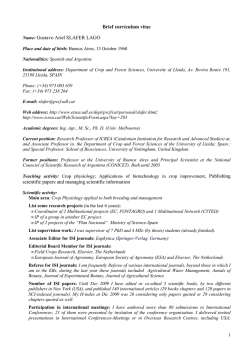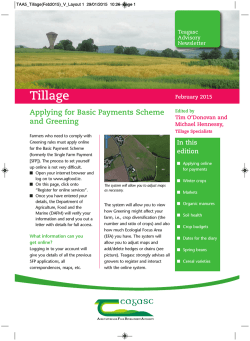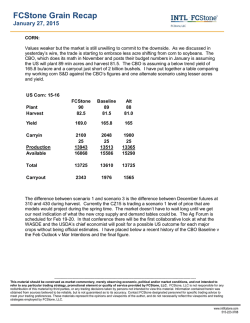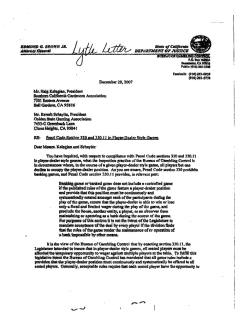
Biotechnology: Cause and Consequence of Change in Agriculture
Biotechnology: Cause and Consequence of Change in Agriculture R. JAMES COOK Washington State University Pullman, WA As I was growing up in rural northwestern Minnesota in the 1940s and 50s, the major—if not, only—considerations by farmers of whether or not to adopt a new technology were based on whether it would raise yields, save labor, or otherwise pay economically. I recall the adoption of 2,4-D herbicide in the early 1950s, for control of broadleaf weeds on our family farm. I remember the images of mustard blooming in our fields of small grains only where application had failed, whereas, beforehand, the entire field would be yellow when the mustard was in bloom. At that time, the only hints of an environmental movement were from soil-conservation programs of the United States Department of Agriculture (USDA) and Cooperative Extension Service. In the wake of the “dust bowl” and “dirty thirties” of slightly more than a decade earlier, these programs had promoted contour and strip farming, neither of which paid economically, nor did they work well enough to stop the erosion caused by a typical Minnesota summer thunderstorm. The environmental movement in progress today, with its focus primarily on the elimination of chemical pesticides, undoubtedly has multiple origins, but traces most visibly to Rachel Carson’s Silent Spring, published in 1962. This watershed book caused farmers, scientists, and the agricultural industries to look beyond the economics of new farm practices. Economics was no longer the only factor to consider. The result has been an avalanche of change, including more research on biological control and integrated strategies for management of pathogens and pests. Agribusinesses have redirected their R&D 39 to products with specific targets as replacements for broad-spectrum pesticides. There now are requirements that every pesticide applier maintain updated training and be licensed. Comprehensive record-keeping by growers, and intensive “market basket” sampling and testing of fresh produce by the Food and Drug Administration for off-label chemical residues are now the norm. Silent Spring may also be considered one of the origins of the social awareness that agriculture must now consider when adopting or continuing a new technology, practice, or system. Today, growers are finding various ways to balance and integrate three drivers of the sustainability. These are economic, including ability to compete in a global economy, environmental, i.e., be in compliance with environmental requirements, particularly clean water and air, and social, i.e., meet the safefood and other demands of consumers and customers specifically and of society more generally. If a product or practice fails the test of acceptability for any one of these three factors, it may continue in the short term, but will not be sustainable in the long term. Biotechnology has been a boon to the environmental and, to some extent, the economic drivers of sustainability, but, clearly, the jury is still out on its broad acceptance in society. It is often said that agricultural biotechnology would be more readily accepted by society if the benefits to consumers were more obvious, as they are with medical biotechnology. Wider benefits are forthcoming, including novel raw materials for the manufacturing industry that currently depends on petrochemicals, more-digestible animal feeds, foods higher in essential nutrients or lower in allergenic proteins, and plants as cheaper ways to meet the needs of medicine for specialty proteins (pharm plants) to treat chronic human diseases. Because of public resistance, fear of rejection by foreign customers, or other consumer/customer/societal issues, I am concerned that agbiotech companies might abandon the currently available applications of socalled “in-put” traits that benefit the producer (and hence the consumer) economically and that also benefit the environment and natural resource base, and concentrate instead on second- and third-generation “out-put” traits (products) with their more direct and readily apparent benefits to society. It is here, essentially still at the “starting gate”—as much as or more than any other application of biotechnology—that science and society are at a crossroads. This paper is, therefore, focused on how and why biotech fits into the dynamics of change down on the farm, where its adoption is as much a consequence as it is the cause of this change. OUTCOME MEASURES OF MODERN AGRICULTURAL SYSTEMS Rather than a single-issue focus on biotechnology, the changes in agriculture are better considered in terms of outcome measures and the recognition that farming, regardless of its label—conventional, organic, subsistence, industrial— is a system. In this context, biotechnology is but one of several innovations that 40 Biotechnology: Science and Society at a Crossroad are both cause and consequence of change in agriculture. Other major innovations include the use of direct seeding or “no-till” farming, precisionagriculture technologies, and information technology. Not surprisingly, each of these changes has met with resistance. As one outcome measure of the farming systems in place today in North America, there likely will not be another “dust bowl” on this continent, thanks to a 60-year trend towards technologies and management practices developed and adopted to save, and even rebuild, soils. These changes started with physically altering the landscape: the contour and strip farming mentioned above. These approaches to soil conservation have been increasingly complemented or replaced by mulch-tillage, minimum tillage, strip-tillage, ridge-tillage, and now direct-seeding. Direct-seeding—the placement of seed and fertilizer directly into undisturbed soil with no prior seedbed preparation—not only prevents soil erosion, it increases sequestration of carbon dioxide and helps farmers reduce fuel and labor costs while protecting water and air quality and providing habitats for birds and other wildlife. While identified with large-scale farms in developed countries, direct-seeding is also coming into use on small-scale farms in developing countries (CIRAD, 2002; Javier, 2002). As a bonus, the accumulation of soil organic matter in directseeded fields represents sequestered carbon as an offset to carbon dioxide emitted by cars and coal-fired sources of heat and energy. Merkel (1998) defined sustainable growth as: The use of natural resources no faster than they can regenerate themselves, and the release of pollutants to no greater extent than natural resources can assimilate them. Direct-seeding leads dramatically to conservation of soil, water, and fossil-fuel resources while allowing minimal transfer of soil sediments, dust, pesticides, plant nutrients, and greenhouse gases to other environments, and, therefore, is clearly consistent with the goals of sustainable growth. One-third of the 75 million acres of soybeans in the United States is now direct-seeded (Table 1). More than 60% of US soybean growers interviewed by the Conservation Technology Information Center (CTIC) credited herbicidetolerant (Round-up Ready®) varieties for weed control as the key factor in their decision to reduce or eliminate tillage. Of course, some farmers use directseeding but not herbicide-tolerant varieties and the converse; and the limited area of direct-seeded wheat in the United States (10–12% of the acreage) is done without herbicide-tolerant varieties. On the other hand, there is little doubt that reaching the next plateau in adoption rates of direct-seeding for wheat and barley will almost certainly follow the availability of herbicidetolerant varieties. An even higher adoption rate for wheat and barley will follow the availability of varieties with resistance to the root diseases favored by directseeding (Cook, 2001). Cook 41 TABLE 1. AREA OF DIRECT-SEEDING FOR SELECTED CROPS IN THE UNITED STATES IN 2002 (CTIC, 2002). Crop Corn Sorghum Small grains (spring) Small grains (fall) Soybean (full season) Soybean (double-crop) Cotton Total Direct-seeded millions of hectares 78.6 15.0 9.5 1.4 32.5 4.1 43.3 4.7 69.8 23.1 4.8 3.0 14.6 2.0 % 19 14 12 10 33 62 14 As another outcome measure of today’s farming systems, the world market for pesticides, valued at $30 billion in the 1990s and at about $20 billion in 2003, is dropping at the rate of 2 to 3% per year (Kishore, 2002). The National Center for Agricultural and Food Policy (NCAFP) estimated that just eight transgenic crops currently grown in the United States resulted in a reduction of 46 million pounds of pesticides used in 2002 alone (Gianessi et al., 2002). Most of this reduction occurred with the adoption of cotton cultivars with the Bt gene for resistance to insect pests. In China, insecticide use on cotton has been reduced by thirteen spray applications per hectare per season because of the use of Bt varieties, saving $762/ha per season (Huang et al., 2002). Bt cotton is also now grown in Australia, South Africa, and India, and may soon be in use in Egypt. According to James (2002), the majority of farmers adopting Bt crops globally operate small holdings. ENVIRONMENTAL SAFETY ISSUES EXPAND TO INCLUDE THE CROP VARIETY To my knowledge, throughout the approximately 100 years of variety development by conventional plant breeding based on an understanding of Mendelian genetics, the question of whether or not the new variety itself—or the gene that made the variety special—might have a negative impact on the environment has never been addressed. Instead, our understanding of environmental impacts and efforts to reduce them through science, education, regulations, and innovations have been based on two principles. • It is the management used to grow the variety, i.e., the intensity of tillage, pesticide use, planting date, irrigation, etc., and not the variety itself that has impact on the environment. • Each new crop variety usually leads to changes in the management system used to grow that crop. 42 Biotechnology: Science and Society at a Crossroad A new high-yielding variety may require more fertilizer or pesticides to attain its full potential, as was the case with the IR8 semi-dwarf variety of rice released by the International Rice Research Institute (IRRI) in the 1960s. In this example, management, especially fertilization and pesticide application, changed in response to needs of the variety. The breeding programs that followed up on this breakthrough in yield potential, and that continue to this day, have worked largely to develop replacement varieties that maintain the high yield potential but also have genes for resistance to diseases and pests as well as improvements in other agronomic traits and quality measures. The replacement varieties may have no higher yield potential, but rather—and often just as important—they allow the crop to be produced with management that is both more economical and has less impact on the environment. In the example of direct-seeding to protect soil, water, and air resources by preventing soil erosion, the change in management happened first, and is now being followed by the development of varieties that fit the management, such as soybeans with herbicide-tolerance. Again and again, changes in agriculture worldwide have followed a pattern of varieties bringing about new management and new management making it necessary to develop new varieties. Herbicide-tolerant varieties have been adopted because of their fit with direct-seeding and the Bt hybrids of corn and Bt varieties of cotton with their genetically-based resistance to insects are replacements for insect-susceptible hybrids and varieties that preceded them— like the disease- and insect-resistant varieties of rice that have replaced IR8 and its successors over the past 40 years. There seems little reason to doubt, based on all of the evidence to date, that the principle—it is the management used to grow the variety and not the variety itself that has impact on the environment—holds just as true for transgenic as for conventionally bred varieties. Nevertheless, developers of transgenic crops and the scientific community more generally are now attempting to assess the impact, if any, of the new crop variety itself on the environment. Thus far, other than pollen flow between varieties of the same crop (Rieger et al., 2002), all claims of potential adverse or unwanted non-target environmental effects of transgenic varieties remain hypothetical, unconfirmed, or have been disproved. For example, Sears et al. (2001) concluded, following an extensive, multilocation, multi-investigator field study, that management practices such as planting date, control of milkweed with herbicides or cultivation, and insecticide applications, affected monarch butterflies, but that Bt hybrids of corn themselves had no measurable or significant effect on these insects. Similarly, Saxena and Stotzky (2001) found no measurable effect on earthworms, soil bacteria, or soil fungi of Bt protein released into soil from roots of transgenic corn. One of the greatest challenges with any study intended to assess the environmental impact of a specific crop variety—e.g., a transgenic variety— is the choice of a control. Even without the research, no one would expect to Cook 43 conclude that plowing the soil, irrigating the crop, rotating corn with soybean, or just growing corn, has no measurable effect on earthworms, soil bacteria, or soil fungi. On the other hand, documenting the environmental impact of even one crop as a crop, whether corn, soybean, wheat, tomato, potato, or any other, as the baseline or background against which to compare the effects of that same crop with a transgene could rival or exceed the scope of the human-genome project. The Environmental Protection Agency (EPA) avoids this challenge in the case of transgenic resistance to pests and diseases by requiring tests specifically with the gene product based on protocols developed for chemical pesticides. Such tests would be impossible for conventionally bred resistance in wheat to, for example, Russian wheat aphid, green bug, or Hessian fly—all of which are in use in the United States—because there is little knowledge of the mechanism(s) of resistance and no knowledge of the gene products responsible. The introduction of the next generation of transgenics into cropping systems—especially varieties transformed to produce novel proteins for use in medicine—presents a much greater unknown in terms of potential environmental impact. In this respect, experience gained and the techniques already developed to measure and monitor the effects of transgene products can provide the science-base needed to measure and monitor environmental effects, if any, of genes responsible for novel out-put traits. However, while the market potential for out-put traits, especially proteins for pharmaceutical use, no doubt can pay the high costs of the tests and evaluations required by the regulatory agencies, thus far only the market potential for applications such as herbicide tolerance and Bt resistance in the major crops has justified the regulatory costs needed for approval of in-put traits. Herein exists another reason for my concern that the use of biotechnology in agriculture will pass over the almost unlimited array of available and potential in-put traits that would benefit the efficiency and environmental sustainability of production agriculture and pursue instead the development and production of novel and readily marketable out-put traits. MODELS BASED ON GENETIC APPROACHES USED FOR PACIFIC NORTHWEST WHEAT AND BARLEY The Pacific Northwest (PNW) region has long been committed to genetic approaches to improving its wheat and barley industries economically, environmentally, and socially. Given below are six examples of genetic approaches in use, or that could be used for the net benefit of the PNW wheat and barley industries and the environment. They appear promising but are not entirely without risk. Introduction of Dwarfed Varieties of Wheat The PNW was the first region in the western world to grow dwarfed varieties of wheat. In the late 1940s, Orville Vogel produced a dwarfed breeding line by 44 Biotechnology: Science and Society at a Crossroad transfer of the Rht dwarfing gene (Figure 1) from a variety obtained from Japan. He then used this new line in conventional plant breeding, and he shared it with wheat breeders worldwide, including Norman Borlaug, CIMMYT, Mexico. Figure 1. Examples of the effects of the Rht1 and Rht2 dwarfing genes alone and combined on the height of wheat. (Photograph by R.E. Allan, with permission of R.E. Allan and the American Phytopathological Society.) The 30 to 40% higher yields from semi-dwarf ‘Gaines’ and ‘Nugaines’ varieties were estimated to increase the income of Washington farmers by $50 million per year, starting in the early 1960s when these varieties were introduced. Like the example of IR8 rice given above, the risk that accompanied the widespread and rapid adoption of these new high-yielding varieties was that the management needed to obtain their high yield—early seeding on summer fallow and heavy use of nitrogen fertilizer—favored stripe rust caused by Puccinina striiformis, foot rot caused by Pseudocercosporella herpotrichoides, and crown rot caused by Fusarium pseudograminearum and F. culmorum. Crown rot was brought largely under control on winter wheat by changes in management practices, namely later seeding on summer fallow and limiting the rates of nitrogen so as to not induce premature water stress (Cook, 1980). Stripe rust and foot rot, on the other hand, were brought under control initially with the aid of fungicides, and are now managed by planting genetically resistant varieties (Jones et al., 1995; Line, 2002). Cook 45 Management of Stripe Rust Since the late 1960s, all varieties of wheat released by PNW breeders have had one or more genes for resistance to stripe rust (Line, 2002). Two kinds of resistance have been in use: • race-specific, single-gene, immunity expressed at all stages of plant development, in which the genetics of the host-pathogen interaction follows the gene-for-gene model; • race-nonspecific, multiple-gene partial-type resistance expressed largely or entirely in adult plants, and in response to high temperatures, also known as high-temperature, adult-plant resistance. Race-specific, single-gene immunity is readily defeated by the pathogen, with the result that each new gene deployed in a new variety selects eventually, and sometimes quickly, for a new race of the pathogen. Approximately ninety races of the stripe-rust pathogen now exist whereas only one was known in the 1960s (X.M. Chen, personal communication). Nevertheless, through a combination of varieties with high-temperature adult-plant resistance, the use of several sources of single-gene resistance in isolines mixed to provide a multi-line (e.g., the multi-line ‘Crew’) and deployment of combinations of single genes as stacked genes, stripe rust remains largely under control through plant breeding (Line, 2002). This is one of many success stories worldwide of a plant disease managed by host-plant resistance. Management of Foot Rot In the 1970s, Robert Allan, a wheat geneticist then with the Agricultural Research Service, located at Washington State University, obtained a breeding line of wheat developed in France with the Pch1 gene for resistance to the psuedocercosporella (strawbreaker) foot-rot disease of winter wheat caused by Psuedocercosporella herpotrichoides (Jones et al., 1995). This breeding line was a product of an interspecific cross between common wheat and the Pch1-donor, Aegilops ventricosa, a wild relative (Maia, 1967). After nearly 15 years of research, the variety ‘Madsen’ was released (Allan et al., 1987) to become the first variety of foot-rot-resistant winter wheat available to growers in the PNW. Within a few years, this variety became the most widely grown winter wheat in the region. It also eliminated the need to treat some 500,000 acres annually for foot rot, providing a cost savings estimated at $40/acre (Jones et al., 1995). This was only the first of several foot-rot-resistant winter-wheat varieties released by PNW plant-breeding programs at Oregon State University, University of Idaho, Washington State University, and the USDA at Pullman. Breeding for resistance to this disease is now done largely by screening seedlings in the laboratory for an endopeptidase gene closely linked to Pch1 (McMillan et al., 1989), providing one of the first examples of marker-assisted breeding. 46 Biotechnology: Science and Society at a Crossroad Management of Stem Rust of Barley by Genetic Engineering In 2003, scientists at Washington State University and the University of Minnesota reported the successful transfer of the Rpg1 gene for resistance to stem rust in barley (caused by Puccinia graminis var. hordei) to a rustsusceptible variety of barley by genetic engineering, making the latter resistant to stem rust (Hovarth et al., 2003). This gene has been used in North America as a source of such resistance in barley for more than 60 years—remarkable durability compared to most sources of resistance based on a single gene. The Agrobacterium-mediated transformation system opens the way for updating popular varieties for resistance to rust by direct and precise transfer of Rpg1. Moreover, because it has been cloned and its sequence known, the gene itself becomes the marker for marker-assisted breeding. Ironically, commercial production of a barley variety with the Rpg1 gene requires approval by the EPA under the Federal Insecticide, Fungicide, and Rodenticide Act (FIFRA) if the gene is introduced by transformation, but not if introduced by conventional breeding. Similarly, based on national organic standards developed by the USDA, a barley variety with Rpg1 is acceptable for organic production if introduced by conventional plant breeding, but not if introduced by the method used by Hovarth et al. (2003). These policies exist in spite of the repeated conclusion from studies and white papers of the National Academy of Sciences (NAS, 1987; 1989; 2000; 2001) that assessment of the risks of any new variety of crop plant should be based on the nature of the variety itself (the product) and not on the modification process. Herbicide-Tolerant Wheat by Mutagenesis For the first time, certified seed of herbicide-tolerant varieties of winter wheat were available to PNW growers for the fall seeding in 2003. These varieties have tolerance to the acetolactate synthase (ALS)-inhibiting family of herbicides, a technology owned and patented by BASF as Clearfield® technology. Unlike Roundup tolerance, which involves introduction by plant transformation of a glyphosate-insensitive variation of the gene for production of the enzyme 5-endopyruvylshikimate-3-phosphate (EPSP) synthase, tolerance to the ALSinhibitory family of herbicides involves the use of mutagensis of the plant’s gene for production of ALS. Four Clearfield®-type varieties of winter wheat have been developed thus far by PNW wheat breeders. Of these, three are herbicide-tolerant selections of existing varieties, i.e., ‘Madsen,’ ‘Stephens,’ and ‘Coda,’ produced by exposing mutagenized seed to lethal doses of the ALSinhibiting herbicide imazamox and picking the survivors. The fourth, developed by Oregon State University by conventional breeding and released as ‘ORCF-101,’ is the product of a three-way cross involving the herbicide-tolerant CV9884 ( produced in France by mutagenisis of the French variety ‘Fidel’) as the donor, and the PNW winter-wheat variety ‘Madsen’ and a ‘Malcom’/ Cook 47 ‘Stephens’ hybrid (Peterson, 2003). These varieties are expected to provide new tools for growers to manage grass weeds that are currently problematic with winter wheat. Obviously, the economic and environmental risks of pollen-mediated transfer of herbicide tolerance to other varieties or weedy relatives of wheat (e.g., jointed goatgrass), and selection of herbicide-tolerant weeds through overuse of one herbicide, must be monitored and managed, whether resistance is induced by mutagensis or introduced by genetic engineering. On the other hand, societal and consumer concerns, nationally and internationally, over food from genetically modified crops using transformation technologies does not apply to Clearfield® technologies. The market and societal acceptance (or indifference) to Clearfield® genetic modification means that growers, the agrichemical industry, and the PNW wheat industry can concentrate on how to manage herbicide tolerance almost exclusively in the context of the economic and environmental drivers of sustainability. Management of Root Rot in Barley Rhizoctonia root rot, the most important root disease affecting direct-seeded wheat and barley in the PNW (Cook, 2001), is caused by Rhizoctonia solani AG8 and R. oryzae (Paulitz et al., 2002). Both induce root rot also of pea, lentil, chickpea, canola, yellow mustard, and safflower, thereby rendering crop rotation ineffective as a method of control. Extensive screening of the gene pools of wheat, barley, and their relatives has failed to produce a useful source of resistance (Neate, 1989; Smith et al., 2002a; 2002b). Dasapyrum villosum, a distant relative of wheat, shows evidence of some resistance (Smith et al., 2002b), but, thus far, it has not been possible to transfer it into wheat by conventional methods, including by chromosome substitution and manipulation. Several cultural practices make it possible to reduce the risk of root rot, but even direct-seeded wheat, grown with best management, yields only 80 to 85% of the crop’s potential with healthy roots (Cook et al., 2002). The fact that it is delaying the adoption of a better way of farming, that it cannot be controlled by crop rotation, and that there is no useful or accessible source of resistance available for use in conventional breeding makes Rhizoctonia root rot a logical candidate for control by genetic engineering. Transgenic resistance to both species of Rhizoctonia has been produced in barley by transfer of the ThEn42 gene from the fungus Trichoderma harzianum (Wu, 2003). This gene encodes an endochitinase that softens the cell walls of the pathogens. Barley was selected as the vehicle for testing this gene because a) it is more susceptible than wheat to Rhizoctonia root rot, b) being a diploid, the genetics are less complicated than that of hexaploid wheat, and c) a transformation method is available and in use for barley at Washington State University (Hovarth et al., 2002). Even if not also used in wheat, through genetic engineering of barley, PNW farmers could someday have the first 48 Biotechnology: Science and Society at a Crossroad rotation crop for management of Rhizoctonia root rot in direct-seed systems. Of course, achieving the end result of a Rhizoctonia-resistant variety of barley for use by PNW growers will be much more expensive and complicated than simply backcrossing the ThEn42 gene from a transgenic line into an agronomically acceptable line, as done to produce the semi-dwarf ‘Gaines,’ root-rot-resistant ‘Madsen,’ and herbicide-tolerant ‘ORCF 101’ described above. Use of ThEn42 will also require arrangements and, presumably, compensation for ownership of intellectual property needed to produce the Rhizoctoniaresistant barley, and clearance of federal regulatory hurdles will be necessary because the source of resistance is a transgene. ROLE OF PUBLIC-SECTOR INSTITUTIONS Barley resistant to Rhizoctonia would greatly facilitate the adoption of directseeding and give farmers peace of mind that root rot will not produce the next “wreck” on their farms. However, it is not likely be needed on more than 500,000 acres of PNW farmland. Multinational corporations are unlikely to develop a transgenic technology to control one disease on only a few hundred thousand acres, and small plant-breeding programs are unlikely to have the capital to invest in obtaining the necessary regulatory approvals. Whether 100, 1,000, or 500,000 acres, all represent “minor use,” especially for an agronomic crop such as barley. Indeed, “minor use” describes the majority of future and potential applications of biotechnology for disease and pest control by transgenic technologies, as has been the case since the beginning of modern breeding for disease and pest resistance. “Minor use” includes virus-resistant varieties of squash and papaya listed among the eight case studies in commercial use and assessed by NCAFP (Gianessi et al., 2002), but which make up less than 1% of the acreage of transgenic crops (James, 2002). In 2001, the NCAFP estimated that 950 USDA-funded and land-grant university projects were underway on use of transgenic resistance to insect pests and plant diseases (Silvers, 2001). Moving even one new variety with transgenic resistance into application would be a formidable undertaking for any one land-grant university, considering the costs of regulatory approvals, intellectual property issues, and public education. On the other hand, how else will the benefits of this technology be made available for use in minor crops or minor uses in major crops such as wheat and barley if not with the involvement of public-sector institutions? Moreover, what better platform for public education by university extension programs on the risks and benefits of biotechnology to agriculture than with a proposed release of a universitydeveloped transgenic variety? Opportunities for public-sector institutions are unlimited. Opportunities for the private sector are unlimited as well, including partnerships with smaller seed and plant-breeding companies, following the lead of public-sector institutions. Cook 49 Achieving the vision for public-sector leadership for “minor-use” applications of biotechnology will require teamwork involving the traditional USDA/landgrant university partnership, the professional scientific societies, federal regulatory agencies, state departments of agriculture, environmental groups, the international agricultural research centers, and grower organizations, to name the most obvious potential team members. The formation under leadership of the Rockefeller Foundation of the Public Intellectual Property Resource for Agriculture (PIPRA, www.pipra.org), as a means for public institutions to share or limit the cost of intellectual property for developing new varieties, is a model for what might be done to share safety data and limit the costs of federal regulatory approvals. The USDA and land-grant university IR-4 project for obtaining data needed to register minor-use pesticides is another model by which promising transgenic technologies could be moved through the testing and regulatory processes for EPA, USDA, and FDA approval. With the great majority of the costs needed to develop and facilitate the adoption of transgenic crops still largely ahead for both public-sector institutions and private companies, one question specifically in relation to the development of pest- and disease-resistant varieties should remain front and center: what is the appropriate level of additional oversight for pest and disease resistance developed using transgenic technologies compared to pest and disease resistance developed by mutagenisis, chromosome substitution/ manipulation, and conventional plant breeding? As stated above, the National Academy of Sciences and, more recently, a group of seven national academies of science, have espoused the principle that safety considerations for genetically modified crops should be based on the product and not on the modification process. In 1996, eleven United Statesbased professional scientific societies, representing the plant, soil, microbiological, entomological, and food sciences, challenged the EPA policy to regulate transgenes and their products under FIFRA when the transgenic trait is intended for pest or disease control (IFT, 1996). This ad hoc group endorsed the principle of regulating product and not process, and suggested that a strengthened variation on the current land-grant university variety approval and release process would be adequate for most transgenic crop varieties developed for resistance to pests and diseases. A blue-ribbon panel assembled by the Council for Agricultural Science and Technology (CAST) similarly endorsed the principle of regulating product not process, and concluded that regulations of genes and their products as pesticides was inappropriate (CAST, 1998). Dialog among the many and diverse stakeholders on this issue must continue, but with the clear goal to deregulate those biotechnology applications that, based on the body of scientific evidence, represent no apparent risk to the environment or to people. A technology intended to control one disease or pest of one crop, and a minor crop at that, cannot justify the high costs of regulation that, so far, are justified based on perception of risk and not on weight of evidence based on science. 50 Biotechnology: Science and Society at a Crossroad REFERENCES Allan RE et al. (1989) Registration of ‘Madsen’ wheat. Crop Science 29 1575–1576. CAST (1998) The Proposed EPA Plant Pesticide Rule, Issue Paper No 10. Ames, IA: Council for Agricultural Science and Technology. CIRAD (2002) Towards Sustainable Agriculture: Direct Seeding on Plant Cover. Montpellier: Centre de Cooperation Internationale en Recherché Agronomique pour le Developpement. http://agroecologie.cirad.fr/dmc/ index.php. Cook RJ (1980) Fusarium root rot of wheat and its control in the Pacific Northwest. Plant Disease 64 1061–1066. Cook RJ (2001) Management of wheat and barley root diseases in modern farming systems. Australasian Plant Pathology 30 119–126. Cook RJ et al. (2002) Yield responses of direct-seeded wheat to fungicide and rhizobacteria seed-treatments. Plant Disease 86 780–784. CTIC (2002) Conservation Technology Information Center. West Lafayette, IN: Conservation Technology Information Center. http://www.ctic.purdue.edu/ CTIC/CTIC.html. Gianessi LP et al. (2002) Plant Biotechnology: Current and Potential Impact for Improving Pest Management in U.S. Agriculture, an Analysis of 40 Case Studies. Washington, DC: National Center for Food and Agricultural Policy. http://www.ncfap.org/40CaseStudies.htm. Hovarth H et al. (2003) Genetically engineered stem rust resistance in barley using the Rpg1 gene. Proceedings of the National Academy of Sciences of the USA 100 364–369. Huang J et al. (2002) Plant biotechnology in China. Science 295 674–677. IFT (1996) Appropriate Oversight for Plants with Inherited Traits for Resistance to Pests—A Report from 11 Professional Scientific Societies. Chicago: Institute for Food Technologists. James C (2002) Global Review of Commercialized Transgenic Crops: 2001. Briefs No. 27. Ithaca, NY: International Service for the Acquisition of AgBiotech Applications (ISAAA). Javier E (Ed) (2002) CIMMYT 2000-2001 World Wheat Overview and Outlook. Developing No-Till Packages for Small-Scale Farmers. Mexico City: CIMMYT. Jones SS et al. (1995) Use of alien genes for the development of disease resistance in wheat. Annual Review of Phytopathology 33 429–443. Kishore G (2002) Perspectives on the “Big” Opportunities for Agriculture, Presentation at, BARD’s Goals for a New Millennium: A Roundtable Discussion, Alexandria, VA, January 28–30, 2002. Line RF (2002) Stripe rust of wheat and barley in North America: A retrospective historical review. Annual Review of Phytopathology 40 75–118. Maia N (1967) Obtention de bles tenders resistnts au p;ietinverse par croisements interspecificques bles x Aegilops. Comptes Rendus des Seances de l’Academie d’Agriculture de France 53 149–154. Cook 51 McMillan DE et al. (1986) Association of an isozyme locus and strawbreaker foot rot resistance derived from Aegilops ventricosa in wheat. Theoretical and Applied Genetics 72 743–747. Merkel A (1998) The role of science in sustainable development. Science 281 336–337. NAS (1987) Introduction of Recombinant DNA-Engineered Organisms into the Environment: Key Issues. Washington, DC: National Academy of Sciences. NAS (1989) Field Testing Genetically Modified Organisms. Washington, DC: National Academy of Sciences. NAS (2000) Transgenic Plants and World Agriculture. Washington, DC: National Academy of Sciences. NAS (2001) Genetically Modified Pest-Protected Plants. Washington, DC: National Academy of Sciences. Neate SM (1989) A comparison of controlled environment and field trials for detection of resistance in cereal cultivars to root rot caused by Rhizoctonia solani. Plant Pathology 38 494–501. Paulitz TC et al. (2002) Insights into the prevalence and management of soilborne cereal pathogens under direct seeding in the Pacific Northwest USA. Canadian Journal of Plant Pathology 24 416–428. Peterson CJ (2003) Release of the New OSU Clearfield Wheat Variety. Corvallis, OR: Oregon State University. http://cropandsoil.oregonstate.edu/wheat/orcf101. Rieger MA et al. (2002) Pollen-mediated movement of herbicide resistance between commercial canola fields. Science 296 2386–2388. Saxena D Stotzky G (2001) Bacillus thuringiensis (Bt) toxin released from root exudates and biomass of Bt corn has no apparent effect on earthworms, nematodes, protozoa, bacteria, and fungi in soil. Soil Biology and Biochemistry, 33 1225-1230. Sears MK et al. (2001) Impact of Bt corn pollen on monarch butterfly populations: A risk assessment. Proceedings of the National Academy of Sciences of the USA 98 11937–11942. Silvers C (2001), Statement in Pubic Comment period at USDA’s Meeting of the Advisory Committee on Agricultural Biotechnology. Washington, DC: National Center for Food and Agricultural Policy. Smith JD et al. (2002a) Evaulation of spring cereal grains and wild Triticum relatives for resistance to Rhizoctonia solani AG-8. Crop Science 43 701–709. Smith JD et al. (2002b) Assessment of spring wheat accessions for disease reaction to Rhizoctonia solani AG-8 in controlled environment and directseeded field evaluations. Crop Science 43 694–700. Wu Y-C (2003) Transformation of Barley for Resistance to Rhizoctonia Root Rot, PhD Thesis. Pullman, WA: Washington State University. 52 Biotechnology: Science and Society at a Crossroad
© Copyright 2026






